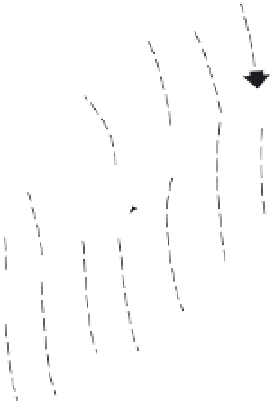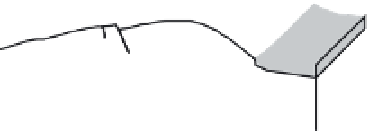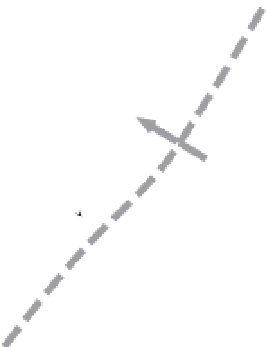Geology Reference
In-Depth Information
A
B
Orthogonal
Oblique
Shortening
Shortening
anticlinal
axis
conjugate
shear zones
anticlinal
axis
conjugate
shear zone
conjugate
shear zones
oblique
shortening
0
400
0
1
meters
km
C
D
Fig. 4.31
El Asnam thrust front and crestal grabens.
A. Map of surface ruptures related to orthogonal shortening during the 1980 El Asnam earthquake. Parallelism of the
crestal graben (bending-moment faulting in the hanging wall) and the frontal thrust and the orientation of the shear
zones suggest that shortening was perpendicular to the thrust trace. Note that the orientation of the conjugate shear
zones is consistent with the local bending-moment tensile stresses across the crest of the anticline, rather than with the
regional stresses responsible for the thrusting. B. Surface ruptures due to oblique shortening, defining
en echelon
crestal grabens and shear zones with respect to the thrust trace. Note the differing orientations of the conjugate shear
zones in the map area. In the crestal region, anticlinal flexure creates bending-moment tensile stresses, whereas shearing
due to oblique shortening controls orientation of tensile stresses along the thrust front. C, D: Schematic block diagrams
showing crestal graben orientation for orthogonal and oblique shortening. Modified after Philip and Meghraoui (1983).
σ
1
σ
1
σ
3
σ
2
σ
2
σ
3
off-fault
extension
σ
3
Fig. 4.32
Styles of
deformation as related to
stress patterns during thrust
faulting.
Dashed lines represent the
approximate orientation of the
regional maximum compressive
stress. Local stress variations
due to flexing or shearing of
hanging-wall anticlines result in
crestal grabens. Modified after
Philip and Meghraoui (1983).
σ
2
σ
1
σ
3
σ
1
en echelon
grabens &
oblique thrusts
σ
1
σ
2
σ
3
σ
2
oblique
thrusts
σ
3
Structures in
Regional Stress Field
orthogonal grabens
& thrusts
σ
2
σ
1




























































































































































































































































































































































































































































































































































































































